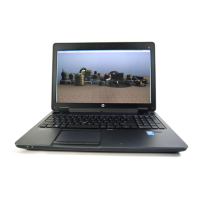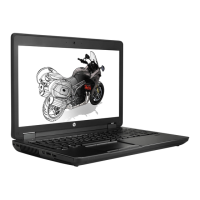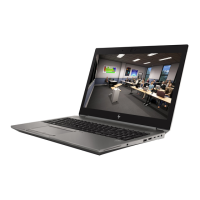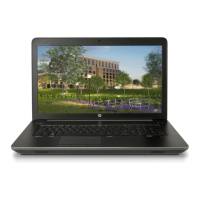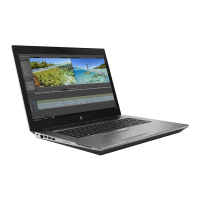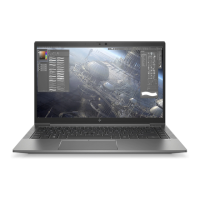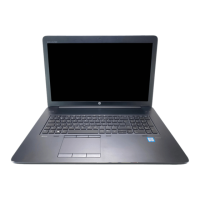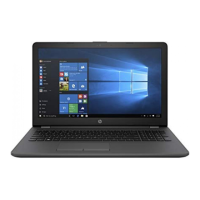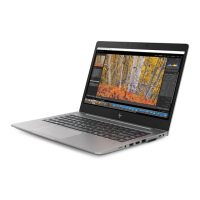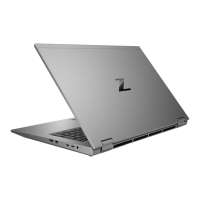Do you have a question about the HP ZBook 15 G4 and is the answer not in the manual?
Details about the various Intel Core and Xeon processors supported in the workstation.
Overview of integrated and discrete graphics options, including NVIDIA and AMD cards.
Details on supported DDR4 memory modules and maximum system RAM configurations.
Specifications for M.2 and 2.5-inch SATA/NVMe solid-state drives and hard drives.
Overview of external ports, media card slots, and network connectivity options.
Description of keyboard features, TouchPad, and pointing stick.
List of preinstalled, restore, and supported operating systems.
Identification and description of ports and connectors on the right side of the computer.
Identification and description of ports and connectors on the left side of the computer.
Identification of display-related components like antennas, camera, and microphone.
Description of keyboard elements including pointing stick, TouchPad, and buttons.
Explanation of system indicator lights such as power, caps lock, and wireless.
Identification and function of power button, wireless button, and fingerprint reader.
Identification of components located on the bottom of the computer, like speakers and vents.
Visual guide to the main internal components of the computer.
Specifications and part numbers for M.2 and 2.5-inch storage drives.
List of tools necessary for performing component removal and replacement.
Key considerations and precautions before disassembling and reassembling the computer.
Procedures to prevent electrostatic discharge (ESD) damage to components.
Detailed steps for removing and replacing specific computer components.
Procedure for removing the display bezel, panel, and camera module.
Step-by-step guide to removing the computer's bottom cover.
Instructions for safely removing and replacing the system battery.
Procedure for removing and installing memory modules.
Steps for removing and installing M.2 solid-state drives.
Steps for removing and installing the computer's system board.
List of HP support tools, websites, and vendor resources for assistance.
A systematic approach to diagnosing and resolving computer issues.
Process for understanding the problem, including boot sequence and failures.
Checking for external factors like connections, power, and interference.
Performing a physical check of computer components for abnormalities.
Importance and procedure for updating system BIOS and device drivers.
Methods for identifying root causes by removing recent changes or testing components.
Overview of HP diagnostic tools for hardware failure analysis.
Information on using HP Support Assistant for updates and diagnostics.
Troubleshooting common problems like power, display, and performance issues.
Instructions for downloading and creating a bootable HP PC Hardware Diagnostics USB drive.
Methods for creating system recovery media and backups.
Options for restoring the computer to its original factory state.
Technical details including dimensions, weight, and operating environment.
Detailed specifications for hard drives and solid-state drives.
Details on types of nonvolatile memory and their usage within HP Business computers.
Common questions and answers regarding BIOS, UEFI, and memory.
General power cord set requirements applicable to all regions.
Specific power cord set requirements and agency certifications by country.
Guidelines for proper battery disposal and HP's recycling program information.
Details about the various Intel Core and Xeon processors supported in the workstation.
Overview of integrated and discrete graphics options, including NVIDIA and AMD cards.
Details on supported DDR4 memory modules and maximum system RAM configurations.
Specifications for M.2 and 2.5-inch SATA/NVMe solid-state drives and hard drives.
Overview of external ports, media card slots, and network connectivity options.
Description of keyboard features, TouchPad, and pointing stick.
List of preinstalled, restore, and supported operating systems.
Identification and description of ports and connectors on the right side of the computer.
Identification and description of ports and connectors on the left side of the computer.
Identification of display-related components like antennas, camera, and microphone.
Description of keyboard elements including pointing stick, TouchPad, and buttons.
Explanation of system indicator lights such as power, caps lock, and wireless.
Identification and function of power button, wireless button, and fingerprint reader.
Identification of components located on the bottom of the computer, like speakers and vents.
Visual guide to the main internal components of the computer.
Specifications and part numbers for M.2 and 2.5-inch storage drives.
List of tools necessary for performing component removal and replacement.
Key considerations and precautions before disassembling and reassembling the computer.
Procedures to prevent electrostatic discharge (ESD) damage to components.
Detailed steps for removing and replacing specific computer components.
Procedure for removing the display bezel, panel, and camera module.
Step-by-step guide to removing the computer's bottom cover.
Instructions for safely removing and replacing the system battery.
Procedure for removing and installing memory modules.
Steps for removing and installing M.2 solid-state drives.
Steps for removing and installing the computer's system board.
List of HP support tools, websites, and vendor resources for assistance.
A systematic approach to diagnosing and resolving computer issues.
Process for understanding the problem, including boot sequence and failures.
Checking for external factors like connections, power, and interference.
Performing a physical check of computer components for abnormalities.
Importance and procedure for updating system BIOS and device drivers.
Methods for identifying root causes by removing recent changes or testing components.
Overview of HP diagnostic tools for hardware failure analysis.
Information on using HP Support Assistant for updates and diagnostics.
Troubleshooting common problems like power, display, and performance issues.
Instructions for downloading and creating a bootable HP PC Hardware Diagnostics USB drive.
Methods for creating system recovery media and backups.
Options for restoring the computer to its original factory state.
Technical details including dimensions, weight, and operating environment.
Detailed specifications for hard drives and solid-state drives.
Details on types of nonvolatile memory and their usage within HP Business computers.
Common questions and answers regarding BIOS, UEFI, and memory.
General power cord set requirements applicable to all regions.
Specific power cord set requirements and agency certifications by country.
Guidelines for proper battery disposal and HP's recycling program information.
| Form factor | Clamshell |
|---|---|
| Product type | Mobile workstation |
| Product color | Black |
| Country of origin | China |
| Panel type | SVA |
| LED backlight | Yes |
| Display surface | Matt |
| Display diagonal | 15.6 \ |
| Native aspect ratio | 16:9 |
| Bus type | DMI3 |
| Tjunction | 100 °C |
| Processor cache | 6 MB |
| Processor cores | 4 |
| System bus rate | 8 GT/s |
| Processor family | Intel® Core™ i5 |
| Processor series | Intel Core i5-700 Desktop Series |
| Processor codename | Kaby Lake |
| Processor frequency | 2.5 GHz |
| Configurable TDP-down | 35 W |
| Processor lithography | 14 nm |
| Processor manufacturer | Intel |
| PCI Express slots version | 3.0 |
| Processor boost frequency | 3.5 GHz |
| Processor operating modes | 64-bit |
| PCI Express configurations | 1x16, 1x8+2x4, 2x8 |
| Thermal Design Power (TDP) | 45 W |
| Maximum number of PCI Express lanes | 16 |
| Motherboard chipset | Intel® CM238 |
| Memory slots | 4x SO-DIMM |
| Internal memory | 8 GB |
| Memory clock speed | 2400 MHz |
| Memory form factor | SO-DIMM |
| Internal memory type | DDR4-SDRAM |
| Maximum internal memory | 64 GB |
| Memory layout (slots x size) | 1 x 8 GB |
| SSD capacity | The Solid State Drive's storage capacity in Gigabytes. |
| SSD interface | SATA |
| Storage media | SSD |
| Total storage capacity | 256 GB |
| Compatible memory cards | SD, SDHC, SDXC |
| Number of SSDs installed | 1 |
| On-board graphics card ID | 0x591B |
| Discrete graphics card model | NVIDIA® Quadro® M620 |
| On-board graphics card model | Intel® HD Graphics 630 |
| Discrete graphics card memory | 2 GB |
| Discrete graphics memory type | GDDR5 |
| On-board graphics card family | Intel® HD Graphics |
| On-board graphics card OpenGL version | 4.4 |
| On-board graphics card base frequency | 350 MHz |
| On-board graphics card DirectX version | 12.0 |
| On-board graphics card dynamic frequency (max) | 1000 MHz |
| Battery capacity | 90 Wh |
| Number of battery cells | 9 |
| AC adapter power | 150 W |
| Number of built-in speakers | 2 |
| Front camera HD type | HD |
| Front camera signal format | 720p |
| Wi-Fi standards | 802.11a, Wi-Fi 5 (802.11ac), 802.11b, 802.11g, Wi-Fi 4 (802.11n) |
| Bluetooth version | 4.2 |
| Top Wi-Fi standard | Wi-Fi 5 (802.11ac) |
| Ethernet LAN data rates | 10, 100, 1000 Mbit/s |
| HDMI version | 1.4 |
| Charging port type | DC-in jack |
| USB 2.0 ports quantity | 0 |
| USB 3.2 Gen 1 (3.1 Gen 1) Type-A ports quantity | 3 |
| Sustainability certificates | ENERGY STAR |
| Pointing device | Touchpad + Pointing Stick |
| Processor ARK ID | 97456 |
| Processor package size | 42 x 28 mm |
| Supported instruction sets | AVX 2.0, SSE4.1, SSE4.2 |
| Intel Identity Protection Technology version | 1.00 |
| Intel Stable Image Platform Program (SIPP) version | 0.00 |
| Depth | 264 mm |
|---|---|
| Width | 386 mm |
| Height | 26 mm |
| Weight | 2600 g |
